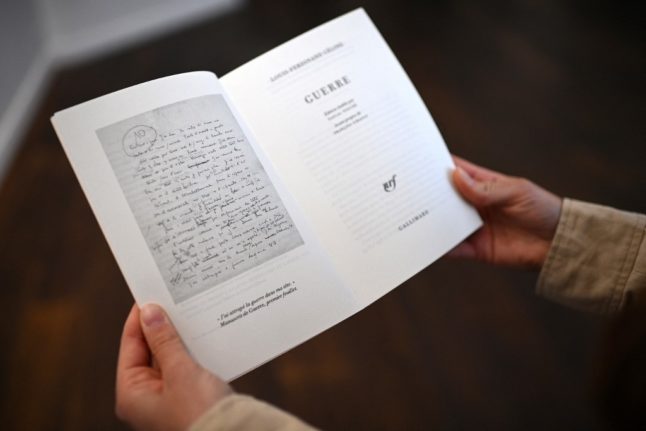‘The Sorrows of Young Werther’ could be considered the world's first best-seller, and its author, Johann Wolfgang von Goethe, is the most celebrated German author in history.
Goethe is on par with Shakespeare for the quality and number of poems and texts he produced in his lifetime, but it was this novel, published in 1774, that catapulted him to international fame at the tender age of 24.
Goethe's novel is loosely autobiographical, written in the form of letters penned by the doomed romantic hero, Werther.
It delves into the psyche of the sensitive and troubled young man as he falls in love and soon becomes obsessed with a woman who can never be his.
Werther descends into despair at the world, his mental state becoming increasingly self-centred and toxic before he eventually shoots himself with a pistol borrowed from the woman’s fiance.
The novel soon gained a cult following as the intense emotions of the protagonist struck a chord with young men and women across Europe.
Young men began to dress like him in blue suits with yellow vests and women even wore a perfume called ‘Eau de Werther’.
But the fanatical behaviour had a darker side and was linked to an increase in suicide rates in several European countries, according to a report commissioned by Mindframe.
A number of these suicides were undoubtedly influenced by the novel. One such case was the death of a young courtier named Christiane von Lassberg who was found dead with a copy of ‘The Sorrows of Young Werther’ in her pocket, after throwing herself into the river Ilm.
In response, the book and Werther’s signature clothing style were soon banned in Leipzig, Italy and Copenhagen and widespread debate about the possible effects of depicting suicide in the media was sparked.
But it was not until 1974, exactly 200 years after the novel was published, that the term the ‘Werther Effect’ emerged.
It was coined by sociologist David P. Phillips to mean a copycat suicide influenced by a real or fictional suicide presented in the media, also known as suicide contagion.
According to a report conducted by the Mindframe National Media initiative, “until the 1960s, debate about the Werther effect was based on anecdotal reports and impressions”, but since then there have been a huge number of scientific studies into the topic, many of which have found evidence linking depictions of suicide in the media with suicidal actions.
One such study was carried out in Germany in 1988 which centered around a television series which depicted the suicide of a male student.
The series had been broadcast twice – once in 1981 and again in 1982 – and the results showed that “after each series there was a significant increase in German suicides involving the same method as that used by the student in the series.”
What’s more the group most affected were of the same sex and roughly the same age as the character.
This effect is not limited to fictional suicides. Another study was carried out in Baden-Württemberg between 1968 and 1980 which showed a correlation between the publication of stories on prominent suicides in major newspapers and an increase in suicides in the following days.
The Werther Effect was cause for concern last year after the release of the hugely popular Netflix series ‘13 Reasons Why’, known in Germany as 'Tote Mädchen lügen nicht', or 'dead girls don't lie'.
Based on a book of the same name, ‘13 Reasons Why’ tells the story of a high school girl, Hannah, who commits suicide but leaves behind 13 tapes accusing a number of people in her life of “causing” her suicide.
Several mental health organizations, including the Jed Foundation and Everymind, voiced concerns about the series for a number of reasons.
These included its potential for heroicizing Hannah’s suicide as a catalyst for social change, the fact that it places the blame on specific events and people, rather than mental health issues and its graphic depiction of suicide.
Despite these concerns, the show gained a great deal of popularity, becoming the most tweeted about series of 2017, and production is well underway for a second season which is likely to air in just a few months.
The creators of 13 Reasons Why released a statement in response to the criticism of the series saying, “We have heard from many viewers that 13 Reasons Why has opened up a dialogue among parents, teens, schools and mental health advocates around the difficult topics depicted in the show.”
It is certainly true that suicide should not be made a taboo subject in the media. Suicide is a worldwide issue and according to Destatis there are around 10,000 suicides per year in Germany alone.
In an article on LinkedIn, Jaela Skehan, a director of the mental health organization Everymind, advocates for constructive and realistic stories on the topic of suicide and urges media outlets and writers to be mindful of how they approach the discussion in the future.
Suicide is preventable. If you or anyone you know is struggling with suicidal thoughts or has been affected by the issues raised please contact Deutsche Depressionshilfe, Samaritans, or Mind. Readers in the US are encouraged to contact the National Suicide Prevention Line on 1-800-273-8255.



 Please whitelist us to continue reading.
Please whitelist us to continue reading.